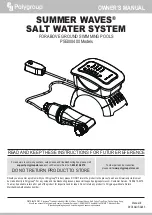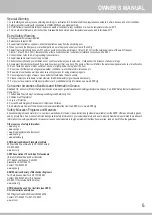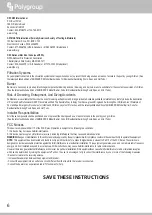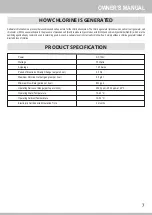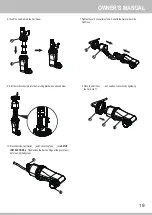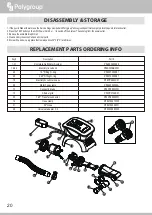
6
WARNING:
1
.
To reduce the risk of injury, do not permit children to use this product unless they are closely supervised at all times.
2.
Risk of Electric Shock. Connect only to a grounding type receptacle. This product is provided with a ground-fault circuit-interrupter. If replacement of the plug or
cord is needed, use only identical replacement parts.
3.
To reduce the risk of electric shock, replace damaged cord immediately.
4.
To reduce the risk of electric shock, do not use extension cord to connect unit to electric supply; provide a properly located outlet.
CAUTION:
1. To reduce the risk of electric shock the pool must be installed no closer than 6 feet (1.8m) from any electrical outlet. Do not place portable appliances closer than
5 feet (1.5m) from the pool.
2. Do not bury cord. Locate cord to minimize abuse from lawn mowers, hedge trimmers, and other equipment.
3. This pump is for use with storable pools only. Do not use with permanently-installed pools. A storable pool is constructed so that it is capable of being readily
disassembled for storage and reassembled to its original integrity. A permanently-installed pool is constructed in or on the ground or in a building such that it
cannot be readily disassembled for storage.
4. For continued protection against possible electric shock this unit is to be mounted to the base in accordance with the installation instructions.
5. The unit is provided with a ground-fault circuit-interrupter (GFCI). To test the GFCI, push the test button. The GFCI should interrupt power. Push the reset button.
Power should be restored. If the GFCI fails to operate in this manner, the GFCI is defective. If the GFCI interrupts power to the pump without the test button being
pushed, a ground current is flowing, indicating the possibility of an electric shock. Do not use this pump. Disconnect the pump, and have the problem corrected by
a qualified service representative before using.
Safety Care for Children
1. Children, especially children younger than five years, are at high risk of drowning. Drowning occurs silently and quickly and can occur in as little as 2 in (5 cm) of water.
2. Keep children in your direct sight, stay close, and actively supervise them when they are in or near this pool and when you are filling and emptying this pool.
3. When searching for a missing child, check the pool first, even if the child is thought to be in the house.
4. Locate pumps and filters in such a way that children cannot climb on them and gain access to the pool.
Swimming Pool Barriers
Very Important:
Swimming pool barriers, which restrict access to the pool by small children, may be required for law. A barrier is necessary to provide protection against potential
drowning and near drowning. Barriers are not a substitute for constant supervision of children. Check state or local laws and codes before setting up pool.
Swimming Pool Equipment
1. The use of artificial pool lighting is at the discretion of the pool owner. Lighting, when installed, should be in accordance with Article 680 of the National Electrical
Code (NEC) or its latest approved edition and in consultation with a licensed electrical professional.
2. Keep all electrical lines, radios, speakers, and other electrical appliances away from the pool.
3. Do not place pool near or under overhead electrical lines.
4. All electrical components installed in and/or adjacent to an aboveground/onground residential swimming pool shall be installed in accordance with and shall
comply with the requirements of the latest published edition of NFPA 70, National Electrical Code (NEC
®
) Article 680 "Swimming Pools, Fountains, and Similar
Installations", and any state or local code.
Filter Pump Awareness
1. The Filter Pump is to be assembled by an adult; care should be taken in the unpacking and assembly of the Filter Pump, this pool may contain accessible
potentially hazardous sharp edges or sharp points that are a necessary part of the function of the Filter Pump.
2. If a drain or suction outlet cover is missing or broken, do not use the pool. Suction can cause body part entrapment, hair and jewelry entanglement, evisceration,
or drowning. Repair or replace the drain or suction outlet cover before allowing the pool to be used. During nighttime pool use, artificial lighting shall be used to
illuminate all safety signs, ladders, steps, deck surfaces, and walks.
3. The floor of the pool shall be visible at all times from the outside perimeter of the pool.
4. Post a list of emergency telephone numbers such as the nearest available police, fire, ambulance, and/or rescue unit. These numbers are to be kept near the
telephone, which is closest to the pool.
5. Basic lifesaving equipment, including one of the following should be on hand at all times:
• A light, strong, rigid pole (shepherd's crook) not less than twelve feet (12’) [366cm] long.
• A minimum one-fourth inch (¼”) [6.35 mm] diameter rope as long as one and one half (1 ½) times the maximum width of the pool or fifty feet (50’) [15.24 meters],
whichever is less, which has been firmly attached to a Coast Guard-approved ring buoy having an outside diameter of approximately fifteen inches (15”) [38.1 cm],
or similarly approved flotation device.
6. Pool shall be located at a minimum distance of 6ft (1.83m) from any receptacle, and all 125-volt 15- and 20-ampere receptacles located within 20ft (6.0m) of the
pool shall be protected by a ground fault circuit interrupter (GFCI), where distances are by measuring the shortest path the supply cord of an appliance connected
to the receptacle would follow, without piercing a floor, wall, ceiling, doorway with hinged or sliding door, window opening, or other effective permanent barrier; to
the inside pool wall.
Circulation Systems
1. Installers shall follow written instructions regarding positioning of all equipment connected to the circulation systems.
2. The installer shall follow written instructions provided for operating the circulation system components.
3. All circulation system components and pumps that require replacement or servicing shall be installed according to the pump’s instruction manual.
4. Circulation equipment shall be installed per manufacturer’s instructions to provide proper mounting and support, to prevent damage from misalignment,
settlement, and vibration, and to minimize the potential for the accumulation of debris and moisture. Please refer to pump’s instruction manual.
Chemicals
For safety sake, ensure the deepest part of the pool is always visible. The user must properly maintain the clarity of the pool water at all times. Check the pH and
chlorine levels periodically and make sure they are within the recommended limits. Additional water treatment chemicals might be needed from time to time. Have
the water sample tested by a local pool supply store to determine if additional chemical is needed. Turn on the pump for the recommended hours daily. If you are
unsure of the time frames please refer to support.polygroupstore.com for the recommended Pump Operation Hours based on pool types and sizes. Clean and
replace filter cartridge frequently. Replace only with genuine Polygroup
®
/ Summer Waves
®
Brand filter cartridge. Refer to the Filter Pump manual for additional water
care information.
Entrapment Risk
1.
Entrapment Avoidance:
There shall be no protrusions or other obstruction in the swimming area, which may cause entrapment or entanglement of the user. If
a suction outlet cover is missing or broken, do not use the pool. Suction can cause body part entrapment, hair and jewelry entanglement, evisceration, or drowning.
Repair or replace the suction outlet cover before allowing the pool to be used.
2. DANGER! TO AVOID SERIOUS INJURY OR DEATH, CLOSE THE POOL OR SPA TO BATHERS IF ANY SUCTION OUTLET COVER/GRATE IS MISSING,
BROKEN, OR INOPERATIVE.
3. Never play or swim near drains or suction fittings. Your body or hair may be trapped causing permanent injury or drowning.
4. Never enter the pool or spa if a suction fitting or drain cover is loose, broken, or missing.
5. Immediately notify the pool/spa owner or operator if you find a drain cover loose, broken, or missing.
Drowning Risk
1. Keep unsupervised children from accessing the pool by installing fencing or other approved barriers around all sides of pool. State or local laws or codes may
require fencing or other approved barriers. Check state or local laws and codes before setting up pool.
2. Toys, chairs, tables, or similar objects that a young child could climb shall be at least four feet (4’) [121.92 cm] from the pool. The pump filter system shall be positioned
so as to prevent it being used as a means of access to the pool by young children. Do not leave toys inside pool when finished using, since toys and similar items
might attract a child to the pool.
3. Position furniture (for example: tables, chairs) away from pool so that children cannot climb on it to gain access to the pool.
Electrocution Risk
1. Keep all electrical lines, radios, speakers, and other electrical appliances away from the pool.
2. Do not place pool near or under overhead electrical lines.
First Aid
1. Keep a working phone and a list of emergency numbers near the pool.
2. Become certified in cardiopulmonary resuscitation (CPR). In the event of an emergency, immediate use of CPR can make a lifesaving difference.
Special Warning
1. Local building codes may require obtaining a building or electrical permit. Installer shall follow regulations on setback, barriers, devices, and other conditions.
2. Safety signs shall comply with requirements of ANSI-Z535 and use signal wording.
3. DO NOT attempt to assemble this pool in adverse weather conditions, windy conditions, or when the temperature is below 60°F.
4. This is a storable filter pump, which should be disassembled and stored when temperatures are expected to fall below 32°F.
Extra Safety Warning
1. Adult supervision is always required.
2. Parents should learn CPR.
3. Keep all electrical radios, speakers, and other appliances away from the swimming pool.
4. When you touch the filter, pump, or electrical parts, be sure the ground under your feet is “Bone Dry.”
5. All electrical outlets should have a GFCI, and connections should be a minimum of 6 feet (1.83 m) from the outside perimeter of the wall of the pool.
From 6–10 feet (1.83–3.05 m), there should be either a fixed connection (outlet box) or twistlock connection with a GFCI.
6. Connect power cords to a 3-wire grounding-type outlet only.
7. Keep all breakable objects out of the pool area.
8. Alcohol consumption and pool activities do not mix. Never allow anyone to swim, dive, or slide under the influence of alcohol or drugs.
9. Severe electrical shock could result if you install your pump or filter on a deck. The pump or filter could fall into the water, causing severe shock or electrocution.
10. Do not install on a deck or other surface at, above, or slightly below the top rail of the pool.
11. Do not use the filter pump during severe weather conditions, i.e. electrical storms, tornadoes, etc.
12. Be aware of overhead power lines when vacuuming your pool or using a telescoping pole.
13. Check regularly for signs of wear or loose bolts that could make the deck unsafe.
14. Please contact pool site dealer or manufacturer for additional safety signs if deemed necessary.
15. For pool service, select a certified pool professional. For additional safety information, see www.APSP.org
Consumer Awareness Booklets and Information Source
Contact:
U.S. Consumer Product Safety Commission at www.cpsc.gov/safety-education/safety-guides/pools-and-spas, Pub. #362 “Safety Barrier Guidelines for
Home Pools.”
1. The Sensible Way to Enjoy Your Aboveground/Onground Swimming Pool
2. Children Aren’t Waterproof
3. Layers of Protection
4. Pool and Spa Emergency Procedures for Infants and Children
5. Be Safety Aware Copies of the above brochures are available free from the APSP. Go to: www.APSP.org
Safety Education Programs and Materials
Educational programs and materials (i.e., seminars, workshops, brochures, videos, instructional guides) are available from the APSP, other aquatic safety groups,
and by private firms. As a means of communicating useful safety information to pool owners/operators, and users, industry members are permitted to provide such
information to owners/operators and to request or require owners/operators to sign a statement that they have received, read, and will follow the guidelines.
Other sources of safety information:
• www.cdc.gov
• www.cpsc.gov
• www.drowningpreventionalliance.com
• www.nspf.org
• www.safekids.org
ANSI American National Standards Institute
25 West 43rd Street, New York NY 10036 Contact:
212-642-4900
www.ansi.org
APSP Association of Pool & Spa Professionals
(formerly National Spa and Pool Institute)
2111 Eisenhower Avenue, Suite 500
Alexandria VA 22314-4679
Contact: 703-838-0083
www.apsp.org
ASME American Society of Mechanical Engineers
Two Park Avenue, New York NY 10016-5990
Contact: 800-843-2763 (U.S. & Canada)
973-882-1170 (outside North America)
www.asme.org
NSPI National Spa and Pool Institute (see APSP)
UL Underwriters Laboratories
333 Pfingsten Road,Northbrook IL 60062-2096
Contact: 877-854-3577 or 847-272-8800
www.ul.com
NSF NSF International
P.O. Box 130140
789 N. Dixboro Road
Ann Arbor MI 48105
Contact: 800-673-6275 or 734-769-8010
www.nsf.org
ASTM ASTM International (formerly American Society of Testing & Materials)
100 Barr Harbor Drive, P.O. BOX C700
West Conshohocken, PA 19428-2959
Contact: 877-909-2786 (USA & Canada) or 610-832-9585 (International)
www.astm.org
NEC National Electrical Code (see NFPA)
NFPA National Fire Protection Association
1 Batterymarch Park, Quincy MA 02169-7471
Contact: 800-344-3555 (U.S. & Canada) or 617-770-3000 (International)
www.nfpa.org
Filtration Systems
Any equipment connected to the circulation systems shall be positioned so as to prevent their being used as a means of access to the pool by young children. (See
the latest published edition of ANSI/APSP-8 Model Barrier Code for Residential Swimming Pools, Spas, and Hot Tubs.)
Barrier
Barriers are necessary to provide protection against potential drowning and near drowning, and barriers are not a substitute for the constant supervision of children.
(See the latest published edition of ANSI/APSP-8 Model Barrier Code for Residential Swimming Pools, Spas, and Hot Tubs.)
Risk of Drowning, Entrapment, And Diving Accidents
Publications are available that describe the risk of drowning, entrapment, and diving accidents. Available publications related to pool safety include the Association
of Pool and Spa Professionals’ (APSP) booklets entitled: The Sensible Way to Enjoy Your Above-ground/O-nground Swimming Pool, Children Aren’t Waterproof,
Pool and Spa Emergency Procedures for Infants and Children, Layers of Protection, and the latest published edition of ANSI/APSP-8 Model Barrier Code for
Residential Swimming Pools, Spas, and Hot Tubs.
Installer Responsibilities
All of these components shall be positioned so as to prevent their being used as a means of access to the pool by young children.
(See the latest published edition of ANSI/APSP-8 Model Barrier Code for Residential Swimming Pools, Spas, and Hot Tubs.)
FCC Notices
This device complies with Part 15 of the FCC Rules. Operation is subject to the following two conditions:
1. this device may not cause harmful interference.
2. this device must accept any interference received, including interference that may cause undesired operation.
WARNING!
Changes or modifications to this unit not expressly approved by the party responsible for compliance could void the user’s authority to operate the equipment.
NOTE:
This equipment has been tested and found to comply with the limits for a Class B digital device, pursuant to Part 15 of the FCC Rules. These limits are
designed to provide reasonable protection against harmful interference in a residential installation. This equipment generates, uses, and can radiate radio frequency
energy and, if not installed and used in accordance with the instructions, may cause harmful interference to radio communications.
However, there is no guarantee that interference will not occur in a particular installation. If this equipment does cause harmful interference to radio or television reception,
which can be determined by turning the equipment off and on, the user is encouraged to try to correct the interference by one or more of the following measures:
• Reorient or relocate the receiving antenna.
• Increase the separation between the equipment and receiver.
• Connect the equipment into an outlet on a circuit different from that to which the receiver is connected.
• Consult the dealer or an experienced radio/TV technician for help.
SAVE THESE INSTRUCTIONS

